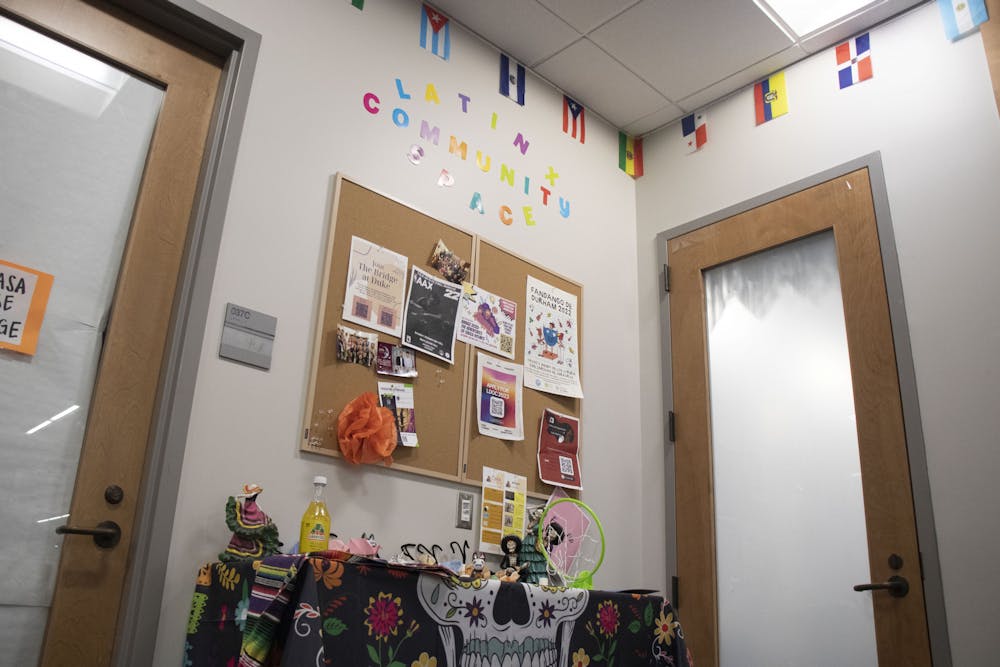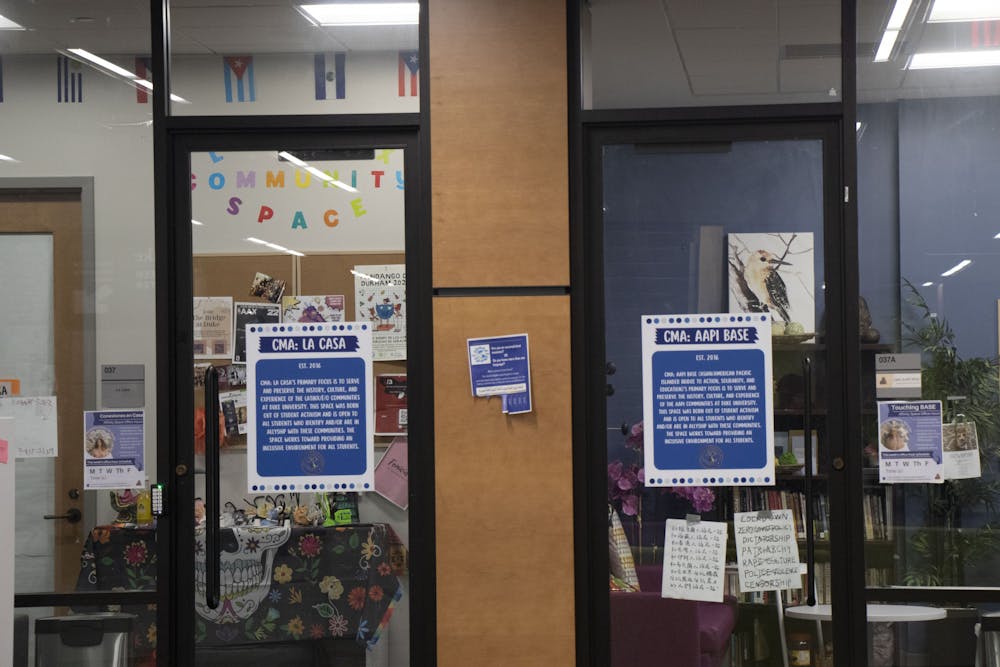La Casa, the Latinx affinity space previously located on the bottom floor of the Bryan Center, used to feel like home to junior Nicole Romero Ospina. It was spacious, with three rooms and a main space. Students came to study, play games or just relax.
But the space Romero Ospina once knew disappeared in summer 2022, as Duke moved most student affinity groups to temporary spaces on the second floor while it works on long-term plans for Bryan Center renovations.
The University’s end goal is to have designated locations for affinity spaces on the upper level, making them “more visible and accessible on the main floor of the building.”
Currently, La Casa is on the middle level of the Bryan Center, but the space is smaller. There’s only one room with a large table, two couches and some desks. Students have tried to make the space feel like it once did, hanging up flags of Latin American countries and portraits of important Latinx leaders, as well as a Día De Los Muertos altar commemorating loved ones.

Although Romero Ospina, who is vice president of Mi Gente, Duke’s Latinx student association, has noticed more foot traffic outside the new La Casa space, this increased “visibility” has also come at a cost of comfort for members — La Casa is enclosed by floor-to-ceiling windows.
“It feels like we’re in a fishbowl, and people are just watching us,” she said.
Administrators also say they’re not satisfied with this short-term allocation of affinity spaces, agreeing with students that there’s still work to be done for groups to feel at home in their campus spaces.
“The reason why we got into this point, in my eyes, is because there was a lack of addressing the main issue — that there's just not enough space. So then, something that should have been handled five or 10 years ago is thrust upon student leaders in 2022,” said junior Isaiah Hamilton, president of the Black Student Alliance and a member of the Multicultural Caucus, where representatives from affinity groups discuss culture and identity issues with administrators.
He believes that if space issues had been addressed years ago, student groups would have had “growth and the opportunity to develop something much more large scale.”
“Now, we're just going to try to make the best-case scenario of a bad situation,” he said.
Bryan Center office moves
For decades, students have advocated for Duke to allocate more resources to multicultural student groups. Frustrations about space allocations are the latest in a long line of tensions between these student groups and administrators, sparked after administrators announced plans to move the Career Center onto the first floor of the Bryan Center in October 2021.
Affinity group leaders responded that students were not sufficiently consulted, and plans were put on hold. Since then, student leaders and administrators have looked to work towards greater collaboration.
The Career Center ultimately moved into the bottom level of the Bryan Center, replacing La Casa, the Center for Multicultural Affairs, and the Asian American Pacific Islander Bridge to Action, Solidarity, and Education (AAPI BASE).
La Casa and AAPI BASE are now temporarily housed in the middle level of the Bryan Center. CMA temporarily moved to the Bryan Center’s first floor, replacing the Office of Student Affairs’ space.
A look at current spaces
Thang Lian, a sophomore and a frequent visitor of AAPI BASE, envisions an ideal BASE with study spaces, a small library and possibly a kitchen, with decorations representing diverse Asian cultures dispersed throughout.
The old BASE was close to Lian’s vision. Though it was located in the Bryan Center’s basement, it was equipped with small study spaces, an office that functioned as a library, a large central gathering space, an outdoor patio and CMA staff offices immersed within the space.
The new BASE, however, is a small room with one large table, a bookcase and some paintings.
Lian emphasized how BASE cannot effectively foster community between students because the students don’t feel connected to the small space.
“It's a base for building connections, for creating a family on campus … You can't do that when students feel like they can't come into the space because it's not big enough,” Lian said. “I just really want it to look like a home.”

Shruti Desai, associate vice president of student affairs for campus life, told The Chronicle she believed that the mid-level Bryan Center move for affinity groups would address student concerns.
“If you look at the history of demands like Native students, Latino students, Asian students, there’s been a ‘get us out of the basement’ repeated theme, and so we tried to honor that,” Desai said. “It seems that for this generation of students, once we did it, it was not a priority for them.”
Romero agrees that visibility is key, but spaces need to at least be big enough to accommodate the sizes of each student affinity group.
For example, Mi Gente had to host their fall semester celebration “Festejando El Año” in the Cultural Affinity Lounge, a space in the middle level of the Bryan Center. The temporary La Casa, which has a capacity of 20 people, couldn’t fit all 50 of the event’s participants as they created decorations for a Christmas tree and crafted thank you cards, according to Fidel Bermudez, a sophomore and Mi Gente programming chair.
‘Willing to take this as a win regardless of the size’
In discussions with Student Affairs after the 2021 announcement of the Career Center’s move to the first floor, Mi Gente President Anthony Salgado, a junior, felt that the message being communicated was that “in order for equity to happen on campus, some groups have to make sacrifices,” referring to student affinity groups sacrificing for the Career Center.
Desai said that conversations from those meetings were about finding space for student affinity groups that previously didn’t have a space.
“[The conversation] wasn't about the Career Center necessarily. It was really about thinking about who doesn't have space and how do we get their voices to the table?” Desai said.
More affinity groups did get space this year for the first time. Only a few steps away from La Casa and AAPI BASE, the Cultural Affinity Lounge now includes space for students identifying as Middle Eastern, North African or Caribbean. It also serves as a second space for DukeLIFE, an organization for students who identify as first-generation and/or low-income.
But Salgado argues that space on its own is not enough — they also have to be functional for programming purposes.
“Now it feels like Duke [administration] is trying to separate us all into different little offices, and that’s not how you make community,” he said. “That’s not how I want my community to look like.”
Still, some students are grateful just to have space, however small. Bre Barrett, a sophomore and social and publicist chair for Students of the Caribbean Association (SOCA), was eager to share her appreciation during the unveiling of “The Yaad,” which means “home” in Jamaican Patois, in early December.
The Yaad takes up three small offices within the Cultural Affinity Lounge. Caribbean flags are pinned on the wall of one room, and a painting paying homage to Caribbean workers and emancipation is displayed in another.

“We can now have general meetings without reserving a classroom… and just a safe space for Caribbean students to feel welcomed,” Barrett said.
SOCA President Shernice Martin, a senior, agrees that the space is a bit cramped, but is excited to see what The Yaad means for Caribbean students and its growth in the future.
“Yes, not a lot of people can fit in there at one time. But we are willing to take this as a win regardless of the size and hopefully allow other students to build upon it,” Martin said.
Moving forward
Desai acknowledged that these changes to the Bryan Center have strained the relationship between students and Student Affairs.
“I think students, justifiably so, feel like their voices weren’t heard when we made these ... decisions. We’ve heard that feedback, but I think it’s impacted our relationship,” Desai said.
As this academic year has progressed, Student Affairs has made efforts to communicate consistently with student leaders as Bryan Center renovation plans develop. These efforts include the formation of the Space Advisory Committee through the CMA and Student Involvement and Leadership. The committee is composed of a freshman or sophomore representative from each of 10 student affinity groups. The committee has held two meetings so far since its creation in late October.
Representatives were tasked with gathering feedback from their communities on whether to pursue a renovation goal by fall 2023 or wait to brainstorm more changes and pursue renovations by fall 2024. They ultimately decided to pursue a renovation goal by fall 2023.
In the latest meeting on Jan. 27, Student Affairs announced the launch of a tab on their site that will have information and updates on affinity spaces. The webpage will also have a section to input feedback that students on the committee will review.
Committee members are discussing physical changes within the Bryan Center with the hope of planning to begin renovations in the summer, according to member Mariana Meza, a first-year.
'Come together collectively'
In the long-term future, student leaders hope for a stand-alone cultural center.
“I want there to be a cohesive cultural space. I hope that the CMA gets to be more connected to cultural organizations and cultural spaces because they are our biggest advocates,” Romero Ospina said.
Desai mentioned that such a center has been discussed, but turning the idea into reality involves finding “the right donor, the right amount of money” and realistically involves a timeline of 10-15 years. She is focused on helping students “right now where they are AND [Student Affairs] realize there's a longer term need.”
“It's really important that we understand that we do have the power to change something, and we come together collectively,” Lian said. “And I think that's the most important step forward.”
Olivia Kim contributed reporting.
Get The Chronicle straight to your inbox
Signup for our weekly newsletter. Cancel at any time.

Michael Ramos is a Trinity first-year and a staff reporter of The Chronicle's 118th volume.

